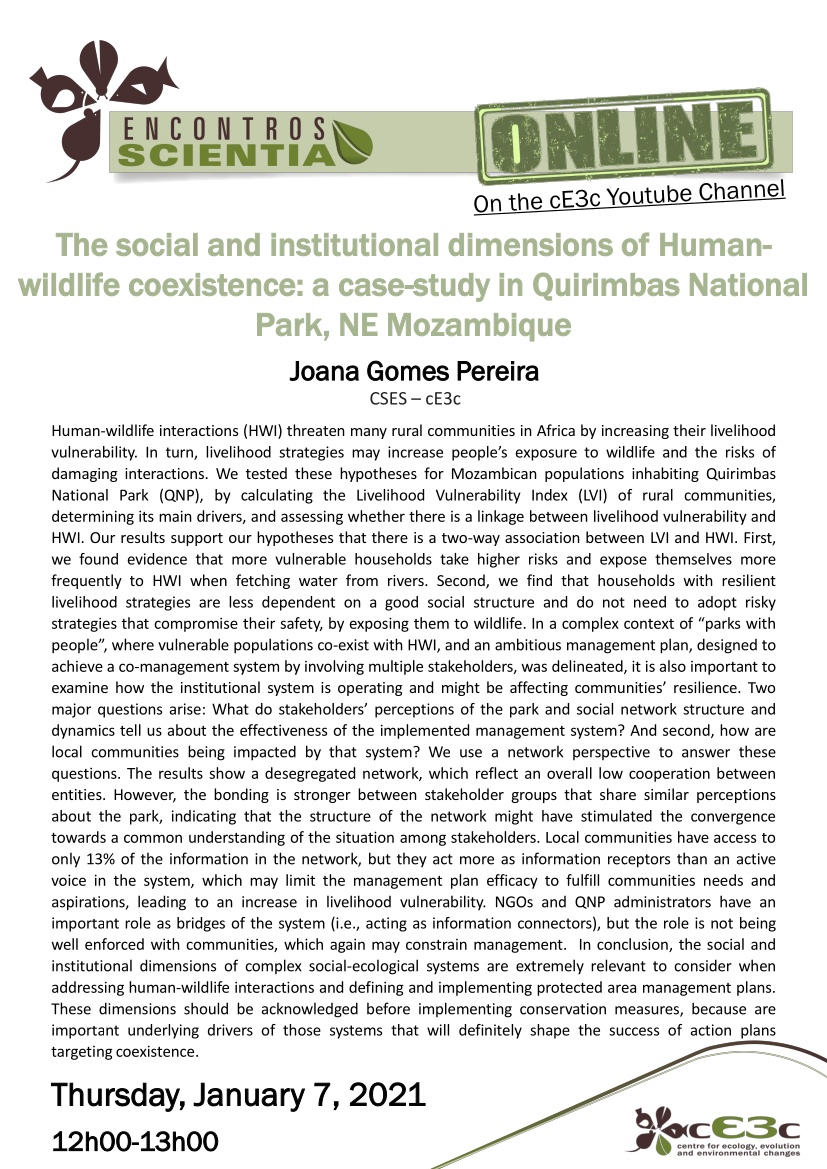The social and institutional dimensions of Human-wildlife coexistence: a case-study in Quirimbas National Park, NE Mozambique
Joana Gomes Pereira (CSES-cE3c)
Human-wildlife interactions (HWI) threaten many rural communities in Africa by increasing their livelihood vulnerability. In turn, livelihood strategies may increase people’s exposure to wildlife and the risks of damaging interactions. We tested these hypotheses for Mozambican populations inhabiting Quirimbas National Park (QNP), by calculating the Livelihood Vulnerability Index (LVI) of rural communities, determining its main drivers, and assessing whether there is a linkage between livelihood vulnerability and HWI. Our results support our hypotheses that there is a two-way association between LVI and HWI. First, we found evidence that more vulnerable households take higher risks and expose themselves more frequently to HWI when fetching water from rivers. Second, we find that households with resilient livelihood strategies are less dependent on a good social structure and do not need to adopt risky strategies that compromise their safety, by exposing them to wildlife. In a complex context of “parks with people”, where vulnerable populations co-exist with HWI, and an ambitious management plan, designed to achieve a co-management system by involving multiple stakeholders, was delineated, it is also important to examine how the institutional system is operating and might be affecting communities’ resilience. Two major questions arise: What do stakeholders’ perceptions of the park and social network structure and dynamics tell us about the effectiveness of the implemented management system? And second, how are local communities being impacted by that system? We use a network perspective to answer these questions. The results show a desegregated network, which reflect an overall low cooperation between entities. However, the bonding is stronger between stakeholder groups that share similar perceptions about the park, indicating that the structure of the network might have stimulated the convergence towards a common understanding of the situation among stakeholders. Local communities have access to only 13% of the information in the network, but they act more as information receptors than an active voice in the system, which may limit the management plan efficacy to fulfill communities needs and aspirations, leading to an increase in livelihood vulnerability. NGOs and QNP administrators have an important role as bridges of the system (i.e., acting as information connectors), but the role is not being well enforced with communities, which again may constrain management. In conclusion, the social and institutional dimensions of complex social-ecological systems are extremely relevant to consider when addressing human-wildlife interactions and defining and implementing protected area management plans. These dimensions should be acknowledged before implementing conservation measures, because are important underlying drivers of those systems that will definitely shape the success of action plans targeting coexistence.
Thursday, January 7, 2020, at 12h00-13h00 (Lisbon, Portugal time)
ONLINE, on our YouTube channel, here: https://youtu.be/mKQFg5Ab52Y

